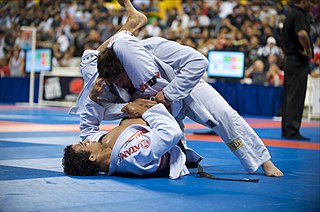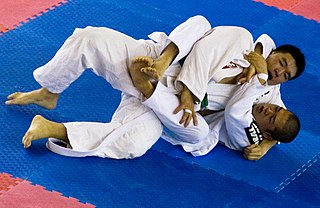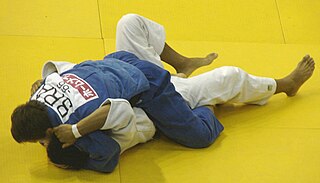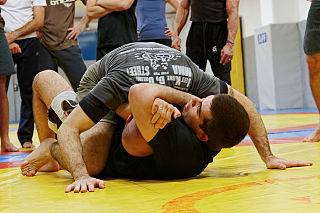Related Research Articles

Grappling, in hand-to-hand combat, describes sports that consist of gripping or seizing the opponent. Grappling is used at close range to gain a physical advantage over an opponent, either by imposing a position or causing injury. Grappling is a broad term that encompasses many disciplines. These various martial arts can be practiced both as combat sports and for self-defense. Grappling contests often involve takedowns and ground control, and may end when a contestant concedes defeat, also known as a submission or tap out.

Brazilian Jiu-Jitsu is a martial art and combat sport based on ground fighting (ne-waza) and submission holds. It focuses on the skill of taking an opponent to the ground, controlling one's opponent, gaining a dominant position, and using a number of techniques to force them into submission via joint locks or chokeholds.

The guard is a ground grappling position in which one combatant has their back to the ground while attempting to control the other combatant using their legs. In pure grappling combat sports, the guard is considered an advantageous position, because the bottom combatant can attack with various joint locks and chokeholds, while the top combatant's priority is the transition into a more dominant position, a process known as passing the guard. In the sport of mixed martial arts, as well as hand-to-hand combat in general, it is possible to effectively strike from the top in the guard, even though the bottom combatant exerts some control. There are various types of guard, with their own advantages and disadvantages.

Renzo Gracie is a Brazilian mixed martial artist and Brazilian Jiu-Jitsu practitioner. A member of the Gracie family of Brazil, Renzo is a 6th Degree Black Belt in Brazilian Jiu-Jitsu under Carlos Gracie Jr. He is the son of Robson Gracie, grandson of Carlos Gracie, nephew of Carlos Gracie, Jr. grandnephew of Helio Gracie, and the 1st cousin once removed of Royce Gracie. In mixed martial arts, Renzo has competed in the Ultimate Fighting Championship, Pride Fighting Championships, K-1, RINGS, and International Fight League. He holds notable victories over five former UFC Champions: Frank Shamrock, Carlos Newton, Pat Miletich, Maurice Smith, and Oleg Taktarov

The rear naked choke (RNC) is a chokehold in martial arts applied from an opponent's back. The word "naked" in this context suggests that, unlike other strangulation techniques found in jujutsu/judo, this hold does not require the use of a keikogi ("gi") or training uniform.
A joint lock is a grappling technique involving manipulation of an opponent's joints in such a way that the joints reach their maximal degree of motion and hyperextension.
An armlock in grappling is a single or double joint lock that hyperextends, hyperflexes or hyperrotates the elbow joint or shoulder joint. An armlock that hyper-extends the arm is known as an armbar, and it includes the traditional armbar, pressing their elbow into your thigh, and the triangle armbar, like a triangle choke, but you press their elbow into your thigh. An armlock that hyper-rotates the arm is known as an armcoil, and includes the americana, kimura, and omaplata. Depending on the joint flexibility of a person, armcoils can either hyper-rotate only the shoulder joint, only the elbow joint, or both the elbow joint and shoulder joint. Generally, armcoils hurt more than armbars, as they attack several joints at the bone and muscle.
A leglock is a joint lock that is directed at joints of the leg such as the ankle, knee or hip joint. A leglock which is directed at joints in the foot, is sometimes referred to as a foot lock and a lock at the hip as a hip lock. Leglocks are featured, with various levels of restrictions, in combat sports and martial arts such as Sambo, Brazilian Jiu-Jitsu, catch wrestling, mixed martial arts, Shootwrestling and submission wrestling, but are banned in some sports featuring joint locks such as judo. The technique has been seen across a wide range of different combat sports and is reportedly over 2,500 years old, having been seen in the lost art of Pankration in the original Olympic Games.

Royler Gracie is a Brazilian-American retired mixed martial artist and Brazilian jiu-jitsu practitioner. He ran the Gracie Humaitá school in Rio de Janeiro for many years under his father Helio's direction, and lives and teaches in San Diego, California. Gracie is a member of the IBJJF Hall of Fame.

A grappling hold, commonly referred to simply as a hold that in Japanese is referred to as katame-waza, is any specific grappling, wrestling, judo, or other martial art grip that is applied to an opponent. Grappling holds are used principally to control the opponent and to advance in points or positioning. The holds may be categorized by their function, such as clinching, pinning, or submission, while others can be classified by their anatomical effect: chokehold, headlock, joint-lock, or compression lock. Multiple categories may be appropriate for some of these holds.

A spinal lock is a multiple joint lock applied to the spinal column, which is performed by forcing the spine beyond its normal ranges of motion. This is typically done by bending or twisting the head or upper body into abnormal positions. Commonly, spinal locks might strain the spinal musculature or result in a mild spinal sprain, while a forcefully and/or suddenly applied spinal lock may cause severe ligament damage or damage to the vertebrae, and possibly result in serious spinal cord injury, strokes, or death. Spinal locks and cervical locks are forbidden in IBJJF Brazilian jiu-jitsu competitions, amateur MMA, multiple forms of no Gi Jiu Jitsu, Judo, and other martial arts. However, professional MMA and some Brazilian jiu-jitsu competitions do permit spinal locks and, particularly, neck cranks, and such moves are trained in various MMA and Brazilian jiu-jitsu schools.

Knee-on-stomach, or knee-on-belly, knee-on-chest, knee-ride, knee mount, is a dominant ground grappling position where the top combatant places a knee on the bottom combatant's torso, and usually extends the other leg to the side for balance. This position is typically obtained from side control, simply by rising up slightly and putting a knee on the opponent's stomach or chest.

A compression lock, muscle lock, muscle slicer or muscle crusher, is a grappling hold that causes severe pain by pressing a muscle into a bone. A compression lock can cause a joint lock in a nearby joint when it is applied by squeezing a limb over a fulcrum. A forceful compression lock may damage muscles and tendons, and if accompanied by a joint lock, may also result in torn ligaments, dislocation or bone fractures. Compression locks can be used as pain compliance holds, and are sometimes featured in combat sports as submission holds.
The Gracie Challenge was an open invitation challenge match issued by members of the Gracie family, representing their self-defense system of Gracie Jiu-Jitsu against challengers of other martial art systems in a vale tudo match.

Tate-Shiho-Gatame (縦四方固) is one of the seven mat holds, Osaekomi-waza, of Kodokan Judo. In grappling terms, it is categorized as a mounted position.

Okuri-Eri-Jime (送襟絞) is one of the twelve constriction techniques of Kodokan Judo in the Shime-waza list.

Brazilian Jiu-Jitsu: Theory and Technique is a book first published in 2001, co-authored by Renzo Gracie, Royler Gracie, Kid Peligro and John Danaher and illustrated by Ricardo Azoury. It was written on the request of Sheik Tahnoon Bin Zayed Al Nayan, creator of the ADCC.

A sweep is either of two categories of martial arts techniques. From standing, sweeps are throws or takedowns that primarily use the legs to attack an opponent's legs. On the ground, sweeps are techniques for reversing a grappling position from a guard position.

Luta Livre, known in Brazil as Luta Livre Brasileira and also Brazilian Submission Wrestling,or Luta Livre Submission is a Brazilian martial art created by Euclydes Hatem in Rio de Janeiro. Primarily a mixture of catch wrestling and kosen judo, there is also striking with the hands, feet, knees and elbows. Notable practitioners include Marco Ruas, Ebenezer Fontes Braga, Johil de Oliveira, Alexandre Franca Nogueira, Renato Sobral, Gesias Cavalcante, Darren Till and José Aldo.
References
| Wikimedia Commons has media related to Ankle locks . |
- ↑ Mifune, Kyuzo (2004) [1960]. The Canon Of Judo. Kodansha International Ltd. pp. 156, 157. ISBN 4-7700-2979-9.
- ↑ Gracie, Renzo and Royler (2001). Brazilian Jiu-Jitsu, Theory and Technique. Invisible Cities Press. p. 146. ISBN 1-931229-08-2.